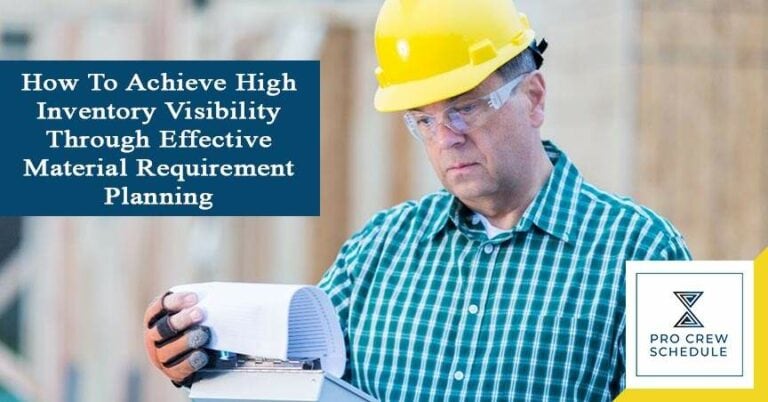A construction project typically involves a million moving parts – from material production and supply chains, equipment rentals, and labor workforce. Thus, implementing a comprehensive inventory management strategy plays a significant role in determining a project’s progress and success when managing construction projects. One of the daunting challenges that a project manager may encounter on site is managing and controlling your inventory efficiently and independently. With the increasing demand for construction services worldwide, the need for specific resources may also drastically increase. You may find yourself caught unprepared by the challenge of ensuring that every resource supply is available onsite when you need it. Still, with the increased inventory storage costs, prolonged supplier lead times, and fluctuating construction costs – it may be impossible to keep the project on track while maintaining the desired quality and keeping within the available budget.
There is no doubt that inventory management plays a crucial role in the project management for construction, and inventory visibility is a critical factor that can determine your project’s success. Inventory visibility is the ability of the team members to view, track and quantify the resources available at a specific time and location – materials, workforce, tools and equipment, and plants; and how the workers are using them. It is crucial to have high inventory visibility for your project at all times – this can help you gain some insights on how to manage your inventory better and minimize all the possible delays that come with it. One strategy to do so is through the implementation of comprehensive material requirement planning (MRP).
In this article, let us understand why you should aim for high inventory visibility and how material requirement planning can help you achieve this. We will also dive in on how construction scheduling software can improve your inventory management style and help you secure your project’s highly coveted success.
Why Should You Aim for High Inventory Visibility For Your Construction Project?
As we have discussed earlier, inventory visibility plays a crucial role in construction projects. The primary aim of high inventory visibility is that every team member has a clear sight of the status of your resources in real-time. And with this, inventory visibility may provide you with all the relevant information needed to make sound business decisions, such as efficiently allocating resources and when to purchase them, and how to prepare for any unexpected problems and delays. Read on to find five reasons why you should aim for high inventory visibility in your construction project.
Better and More Accurate Demand Forecasting
To create more sustainable inventory management in construction, you must predict and forecast the resources needed in your project. You may use your historical data from previous projects and countercheck your current inventory level against the required quantity. This strategy enables you to forecast accurately and ensure that the resource you need for a specific activity is available when you need it, preventing resource shortages and delays.
Efficient Resource Allocation
The highest costs and expenses for a project are the resources, inventory, and assets required to finish it. A crucial part of a construction inventory management system is determining the resource quantity you have right now, how you can allocate your resources for the suitable activity, and ensuring you are only purchasing the right amount and not overbuying. Each unit of inventory is equivalent to a specific amount taken out of your budget. It is essential to keep your inventory levels as low as possible without compromising quality.
Increased Security and Quality Control
High inventory visibility enables you to track every item at any point. Having accurate information allows you to check for any possible material defects, incomplete deliveries, and recalls and easily coordinate with the supplier for any replacements and redeliveries, immediately eliminating potential causes of delays in the long run.
Increased Efficiency and Effective Time Management
Manually tracking all your inventory is very ineffective and time-consuming, to say the least. When it is inevitable to switch warehouse personnel, the construction inventory list often goes missing; some items are unaccounted for, resulting in the owner or project manager reordering the said items to prevent project delays. Not only is this a hassle for all parties, but it is also a waste in terms of costs and even reduces your remaining budget. Having high inventory visibility prevents this problem. The good thing with the construction industry continually making efforts to go digital is that you can use a construction inventory app to ensure that your tracking list is available anytime and anywhere.
Reduce Inventory Wastes
Inventory wastes such as overproduction can be caused by poor workflow processes generating a buildup of inventory. High visibility allows you to plan accordingly and incorporate the construction crew management and inventory management; align these two areas to manage the project better.
What is Material Requirement Planning (MRP) in Construction?
Now that we have defined why inventory visibility plays a crucial role in construction, we will dive in on how material requirement planning can enhance your inventory management, effectively eliminating inefficiencies and ensuring your project’s smooth-sailing progress.
In a simplified definition, material resource planning is the process of effectively allocating both human and non-human resources to a specific task in an effort to maximize the project’s operational efficiency and meet the required specifications by utilizing a master schedule. MRP converts the master schedule into a detailed plan, indicating the number of raw materials, components, or other resources needed for a specific activity.
Material requirement planning involves planning, purchasing, location storage, mode of transportation, inventory controlling, directing, and delivery receiving. This strategy involves the following data:
- Master Schedule
- Bill of Materials
- Supplier Lead Times
- Terms of Demand for Goods
- Existing Inventory on Site
An effective material requirement planning system aims to answer three questions:
- What resources are needed for the project?
- How much is required per specific resource?
- When are the resources required?
Luckily, the material requirement planning process can be done in four easy steps:
Identifying Resources Required
The first step to this strategy is identifying the project scope and deliverables and defining what resources are needed to meet the requirements. The required data may be found in the project’s bill of materials, an itemized list of raw materials, assemblies, and parts and components.
Inventory Tracking and Resource Allocation
Using MRP gives you an overview of the status of your inventory, which in turn gives you high visibility. Inventory tracking, such as identifying which resource is located in your storage, on order, or in transit, can be done quickly, and resources are allocated accordingly.
Production Scheduling
In MRP, a production master schedule is utilized – wherein a project manager can plan out all the resources and timeline per workflow or activity. This schedule also identifies all possible equipment and machinery required to finish the job.
Identifying Possible Issues
Lastly, since the MRP is linked to the status of every resource in the project, it is easier to identify any potential problems and be able to make sound business decisions to solve and prevent any delays.
As mentioned earlier, resources and inventory make up the most significant part of construction costs. Implementing practical material requirement planning to achieve high inventory visibility can result in small savings per item and considerable savings to the total project cost.
How can Construction Scheduling Software Help You Implement A Comprehensive Material Requirement Planning System?
The use of outdated tracking and scheduling tools is often the culprit when it comes to management problems. In the past, construction project managers created a material requirement planning system through manual tools or spreadsheets. In this case, human errors in data entry, counting, and transcription are unavoidable. This process is repetitive and time-consuming, which may lead to employees being unproductive.
However, this method may seem manageable if you are only handling a single project. Still, for project managers who manage multiple projects simultaneously, construction scheduling software may be an excellent tool to make things easier. The benefits of using a software lets you do the following tasks:
- Update inventory information in real-time, when it is pulled out of storage or delivered onsite
- Manage the status of machinery and equipment, and schedule maintenance activities
- Manage reservations, which team or activities need the specific tool
- Create an organized document control system
- Link purchase requisitions, purchase orders, sales invoices, and delivery receipts
Key Takeaway
Resources and inventory play a significant part in the construction cost. Achieving high inventory visibility within your project gives you an excellent overall view of the project and helps you make sound decisions by having complete information on hand. This can be achieved by implementing a comprehensive material requirement planning system (MRP) through the utilization of construction software. MRP allows you to plan the resources required for each activity by detailing the master schedule and efficiently strategize your inventory control and management. By using software instead of manual tools in monitoring your inventory, everything can be organized efficiently and effectively, fast-tracking your construction project’s highly coveted success.







